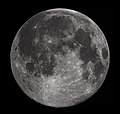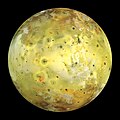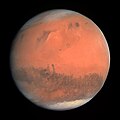Portal:Solar System
The Solar System Portal

The Solar System is the gravitationally bound system of the Sun and the objects that orbit it. It formed about 4.6 billion years ago when a dense region of a molecular cloud collapsed, forming the Sun and a protoplanetary disc. The Sun is a typical star that maintains a balanced equilibrium by the fusion of hydrogen into helium at its core, releasing this energy from its outer photosphere. Astronomers classify it as a G-type main-sequence star.
The largest objects that orbit the Sun are the eight planets. In order from the Sun, they are four terrestrial planets (Mercury, Venus, Earth and Mars); two gas giants (Jupiter and Saturn); and two ice giants (Uranus and Neptune). All terrestrial planets have solid surfaces. Inversely, all giant planets do not have a definite surface, as they are mainly composed of gases and liquids. Over 99.86% of the Solar System's mass is in the Sun and nearly 90% of the remaining mass is in Jupiter and Saturn.
There is a strong consensus among astronomers that the Solar System has at least nine dwarf planets: Ceres, Orcus, Pluto, Haumea, Quaoar, Makemake, Gonggong, Eris, and Sedna. There are a vast number of small Solar System bodies, such as asteroids, comets, centaurs, meteoroids, and interplanetary dust clouds. Some of these bodies are in the asteroid belt (between Mars's and Jupiter's orbit) and the Kuiper belt (just outside Neptune's orbit). Six planets, seven dwarf planets, and other bodies have orbiting natural satellites, which are commonly called 'moons'.
The Solar System is constantly flooded by the Sun's charged particles, the solar wind, forming the heliosphere. Around 75–90 astronomical units from the Sun, the solar wind is halted, resulting in the heliopause. This is the boundary of the Solar System to interstellar space. The outermost region of the Solar System is the theorized Oort cloud, the source for long-period comets, extending to a radius of 2,000–200,000 AU. The closest star to the Solar System, Proxima Centauri, is 4.25 light-years (269,000 AU) away. Both stars belong to the Milky Way galaxy. (Full article...)
Selected article –
Being the most inferior orbiting planet it appears in Earth's sky, always close to the Sun, either as a "morning star" or an "evening star". It stays most of the time the closest to all other planets and is the planet with the highest delta-v needed to travel to from all other planets of the Solar System.
Mercury's sidereal year (88.0 Earth days) and sidereal day (58.65 Earth days) are in a 3:2 ratio. This relationship is called spin–orbit resonance, and sidereal here means "relative to the stars". Consequently, one solar day (sunrise to sunrise) on Mercury lasts for around 176 Earth days: twice the planet's sidereal year. This means that one side of Mercury will remain in sunlight for one Mercurian year of 88 Earth days; while during the next orbit, that side will be in darkness all the time until the next sunrise after another 88 Earth days. Above the planet's surface is an extremely tenuous exosphere and a faint magnetic field that is strong enough to deflect solar winds. Combined with its high orbital eccentricity, the planet's surface has widely varying sunlight intensity and temperature, with the equatorial regions ranging from −170 °C (−270 °F) at night to 420 °C (790 °F) during sunlight. Due to the very small axial tilt, the planet's poles are permanently shadowed. This strongly suggests that water ice could be present in the craters.
Like the other planets in the Solar System, Mercury formed approximately 4.5 billion years ago. There are many competing hypotheses about Mercury's origins and development, some of which incorporate collision with planetesimals and rock vaporization; as of the early 2020s, many broad details of Mercury's geological history are still under investigation or pending data from space probes. Its mantle is highly homogeneous, which suggests that Mercury had a magma ocean early in its history, like the Moon. According to current models, Mercury may have a solid silicate crust and mantle overlying a solid outer core, a deeper liquid core layer, and a solid inner core. (Full article...)
Selected picture
General images
The following are images from various Solar System-related articles on Wikipedia.
Did you know –
- ...that Yogi Rock (pictured) is a rock found on Mars by the Mars Pathfinder mission that looks surprisingly like Yogi Bear's head?
- ...that the Kuiper crater in the Kuiper quadrangle, named after Dutch American astronomer Gerard Kuiper, has the highest albedo recorded on Mercury?
- ...that 6Q0B44E, a recently discovered satellite of Earth, is thought to be a large piece of space debris?
- ...that 17th century philosopher Cesare Cremonini refused to look at the Moon's mountains through Galileo's telescope, because Aristotle had proved the Moon was a perfect sphere?
- ...that the Caloris Basin on Mercury, one of the largest impact basins in the Solar System, is surrounded by a series of geological formations believed to have been produced by the basin's ejecta?
- ...that Kordylewski clouds are large concentrations of dust that orbit Earth at the distance of the Moon?
- ...that no viable solution has yet been found to counteract radiation from space, which is a serious threat to astronauts on any future mission to Mars?
- ...that Claudia Alexander was the last project manager of NASA's Galileo mission to Jupiter?
Categories
| Solar System | ||
|---|---|---|

|
||
| Celestial mechanics | Comets | ...in fiction |

|

| |
| Minor planets | Moons | Planetary missions |

|

|

|
| Planets... | Sun | Surface feature nomenclature... |

In the news
- April 7: NASA's helicopter Ingenuity survives its first night at Mars
- December 25: 'Earth-based life can survive in hydrogen-rich atmospheres': MIT professor Dr Seager tells Wikinews about her research on organisms thriving in oxygen-less environment
- July 7: Astronomer Anthony Boccaletti discusses observation of birth of potential exoplanet with Wikinews
- May 31: SpaceX successfully launches its first crewed spaceflight
- May 22: Astronomer tells Wikinews about discovery of closest black hole known so far
- October 12: Cosmonaut Alexei Leonov dies at age 85
- October 10: Swedish academy announces 2019 Nobel Prize winners in physics
- September 14: Astronomers find water vapour in atmosphere of exoplanet K2-18b
- March 5: SpaceX Crew Dragon capsule docks with International Space Station
- January 9: Simple animals could live in Martian brines: Wikinews interviews planetary scientist Vlada Stamenković
- November 29: NASA's InSight Lander makes it to Mars
- October 12: Manned Soyuz space mission aborts during launch
Major topics

Solar System: Planets (Definition · Planetary habitability · Terrestrial planets · Gas giants · Rings) · Dwarf planets (Plutoid) · Colonization · Discovery timelineˑ Exploration · Moons · Planetariums
- Sun: Sunspot · Solar wind · Solar flare · Solar eclipse
- Mercury: Geology · Exploration (Mariner 10 · MESSENGER · BepiColombo) · Transit
- Venus: Geology · Atmosphere · Exploration (Venera · Mariner program 2/5/10 · Pioneer · Vega 1/2ˑ Magellan · Venus Express) · Transit
- Earth: History · Geology · Geography · Atmosphere · Rotation
- Moon: Geology · Selenography · Atmosphere · Exploration (Luna · Apollo 8/11) · Orbit · Lunar eclipse
- Mars: Moons (Phobos · Deimos) · Geology · Geography · Atmosphere · Exploration (Mariner · Mars · Viking 1/2 · Pathfinder · MER)
- Ceres: Exploration (Dawn)
- Jupiter: Moons (Amalthea, Io · Europa · Ganymede · Callisto) · Rings · Atmosphere · Magnetosphere · Exploration (Pioneer 10/11 · Voyager 1/2 · Ulysses · Cassini · Galileo · New Horizons)
- Saturn: Moons (Mimas · Enceladus · Tethys · Dione · Rhea · Titan · Iapetus) · Rings · Exploration (Pioneer 11 · Voyager 1/2 · Cassini–Huygens)
- Uranus: Moons (Miranda · Ariel · Umbriel · Titania · Oberon) · Rings · Exploration (Voyager 2)
- Neptune: Moons (Triton) · Rings · Exploration (Voyager 2)
- Planets beyond Neptune
- Pluto: Moons (Charon, Nix, Hydra, Kerberos, Styx) · Geology · Atmosphere · Exploration (New Horizons)
- Haumea: Moons (Hi'iaka, Namaka) · Ring
- Quaoar: Weywot · Rings
- Makemake: S/2015 (136472) 1
- Gonggong: Xiangliu
- Eris: Dysnomia
- Sedna
- Small bodies: Meteoroids · Asteroids (Asteroid belt) · Centaurs · TNOs (Kuiper belt · Scattered disc · Oort cloud) · Comets (Hale–Bopp · Halley's · Hyakutake · Shoemaker–Levy 9)
- Formation and evolution of the Solar System: History of Solar System formation and evolution hypotheses · Nebular hypothesis
- See also: Featured content · Featured topic · Good articles · List of objects
Bold articles are featured.
Italicized articles are on dwarf planets or major moons.
Things you can do

 |
Here are some tasks awaiting attention:
|
Related portals
Related WikiProjects
Associated Wikimedia
The following Wikimedia Foundation sister projects provide more on this subject:
-
Commons
Free media repository -
Wikibooks
Free textbooks and manuals -
Wikidata
Free knowledge base -
Wikinews
Free-content news -
Wikiquote
Collection of quotations -
Wikisource
Free-content library -
Wikiversity
Free learning tools -
Wiktionary
Dictionary and thesaurus
















































































